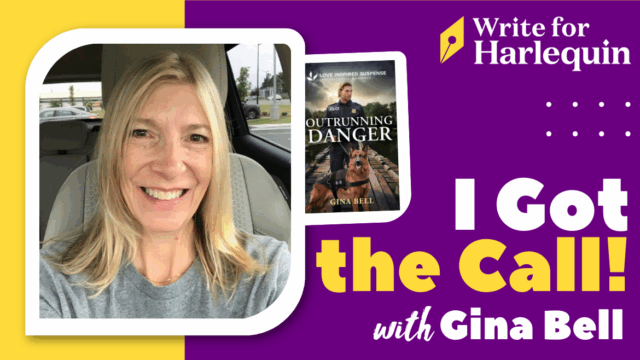
By Editor Emma Cole
Every plot needs to move at a good pace to keep readers interested. But in suspenseful stories, pacing is especially important. If you dish out your mystery too quickly, readers might be confused or feel like the ending of the book doesn’t live up to its promise. If you take too long to ratchet up the tension, readers could get bored before they get to the good stuff. As Alfred Hitchcock said, “There is no terror in the bang, only in the anticipation of it.” It’s great if your characters are surprised by thrilling events, but it’s much more satisfying if the reader knows what’s coming and is waiting for it.
Romantic Suspense vs. Intrigue
One thing to keep in mind when writing for Harlequin is that we have a few series that feature suspenseful elements: Romantic Suspense and Intrigue (as well as Love Inspired Suspense, which has a Christian focus). Our Intrigue series has a stronger focus on procedural crime stories with more time spent on the investigation of the crime. Romantic Suspense, on the other hand, features romance-centered stories with suspenseful elements. Romantic Suspense stories play up the tension in the overall plot as well as the romantic and sexual tension between the two leads, so pacing is particularly important for these stories. Please go to our Submittable page at harlequin.submittable.com to find out more about the submission guidelines for our series.
Are Your Stakes Realistic?
It’s important to make your high stakes realistic. They at least need to make sense within the world of your story. If your suspenseful moments and tense situations aren’t grounded in the universe where your story is set, readers can feel pulled out of the moment. If you’re writing a story about international espionage, you can probably get away with the heroine racing to defuse a dirty bomb that will destroy a city block. A story about a small-town sheriff who is investigating a horse-thieving ring? Not so much.
How Can You Keep Your Plot Moving?
It’s difficult to maintain a really high level of tension if you are moving too fast. Readers might check out if you don’t give them some slower scenes where they can catch their breath. If your story is moving too slow, it can be a bit of a drag. Readers usually need to have strong, suspenseful hook early on to keep them intrigued and stay invested in the story. Problems with pacing can become worse when you layer in romantic elements to your story. So how do you structure your plot in a way that keeps everything moving?
Keep your story on track and structure the parallel romance and suspense storylines separately. Start by writing out a timeline for your romance, then write out the suspense structure. Try to come up with the plot points that you want your characters to experience, and then move these elements into each timeline. Then you can begin to merge the romantic moments with the suspenseful ones, and you’ll be able to keep both timelines moving forward at approximately the same speed. You don’t have to alternate one by one, but having each timeline plotted out separately can help you make sure you’re devoting enough time to each piece of the puzzle.
Let’s look at a very brief (and made up) example.
Romance timeline:
- A man bumps into a frazzled woman at the airport; they’re both trying to catch a flight.
- They miss the plane and the woman offers to rent them a car since they’re going to the same destination.
- They get to know each other a bit.
- They need to stop driving because weather is bad and end up stranded in a motel with only one room available.
- They talk late into the night and realize they’re falling for each other, but their kiss is interrupted.
- The man finds out the woman has been lying to him about who she is and takes off into the night.
- The woman goes after him to explain.
- The woman proves her developing feelings were real.
- The man accepts her apology and the couple picks up where they left off with their kiss.
- HEA.
Suspense timeline:
- A secret agent gets the details of the threat the team needs to look into.
- The agent thinks they have found a good lead and follows the suspect.
- The agent helps their suspect escape from an external threat, but the plan fails due to weather.
- The agent regroups and realizes their suspect is the real villain’s target.
- The target finds out the agent isn’t who they say they are and runs away.
- The real villain captures the target, and the agent must follow the clues to rescue the target.
- The agent has a breakthrough in the case.
- The target is trying to formulate an escape while the villain explains the plot.
- The agent saves the target, and they work together to bring down the villain.
- The agent saves the day.
As you can see, now that we have two distinct storylines that work individually, we can merge these two plots together into a properly paced romantic suspense novel. Start with either storyline, and as you move forward with your synopsis, take elements from each plot and intersperse them together, so both the romance and the mystery build at similar times. Of course, you may choose to focus a little more on the romance than the mystery and vice versa at certain points in the story. But having two parallel timelines can help keep you on track.
What If You Don’t Plot Your Whole Story?
If you are one of those writers who prefers to keep things less structured, of if you’re a full-on pantser (as in, flying by the seat of your pants), is there anything you can do to keep up the pace? Of course! You may not want or need to write a full synopsis hitting every plot point. But you can jot down a list of exciting things. Think cliffhanger chapter endings or jaw-dropping plot twists. Write them down, and when you feel like your story needs a jolt, go through your list and see which one might fit the next scene. Then you can work backwards to build up the tension leading toward that great chapter ender.
Whether you’re looking to slow down or speed up your story, finding the right pace for your book will help you connect your readers to your characters. Need some more inspiration? See tips from some of our Harlequin authors about writing suspense in this article.




